open source hardware overview
13 likes8,124 views
The document discusses the complexities of open source hardware definitions, licensure, and related projects, contrasting it with free software by highlighting the challenges in copying hardware. It introduces various licensing options for hardware, including the TAPR Open Hardware License and others, while outlining best practices for licensing and creating designs. Additionally, it mentions specific projects such as Arduino and Chumby that exemplify open source hardware principles and business models.
1 of 35
Downloaded 259 times
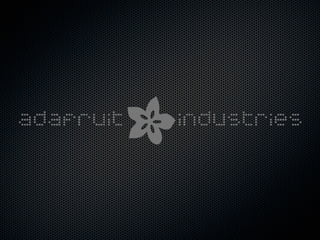
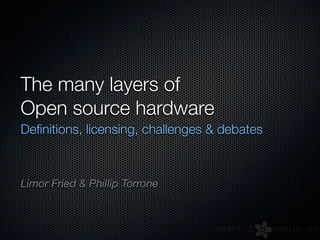
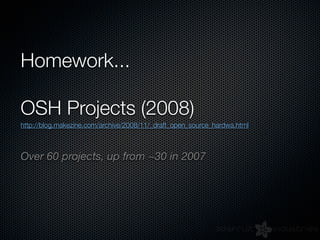
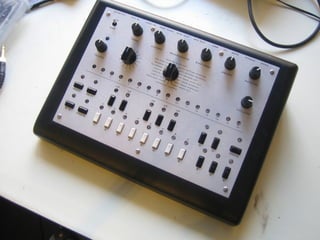
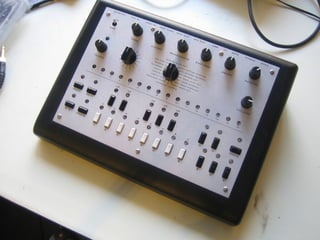
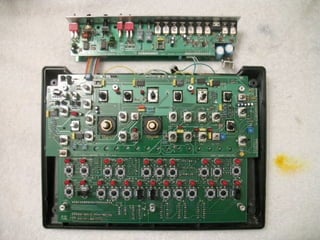
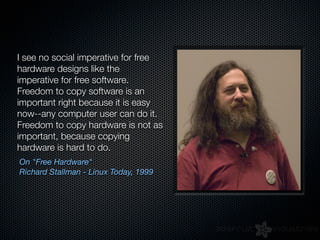
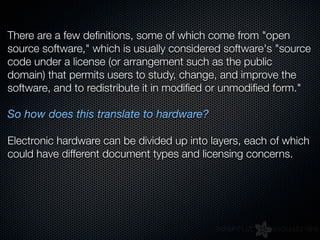
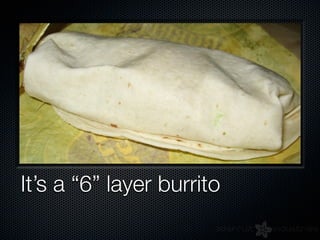
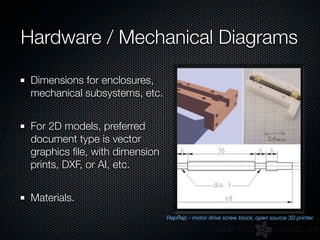
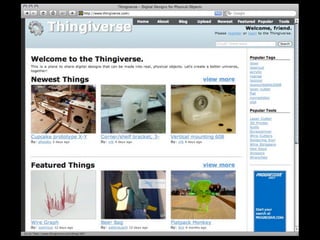
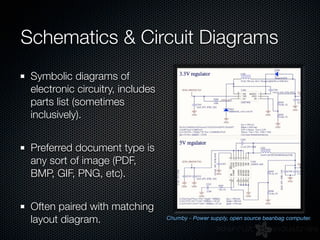
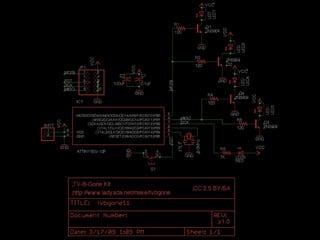
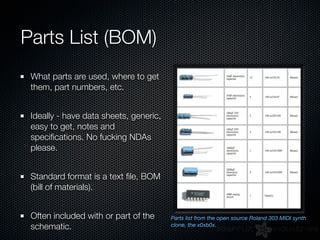
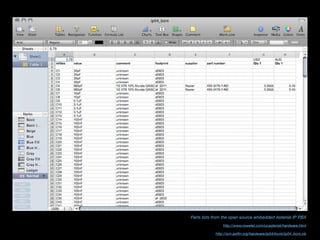
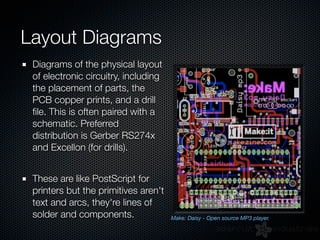
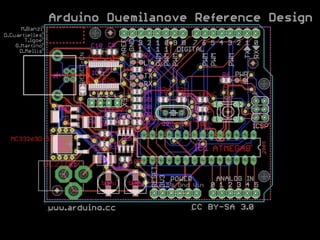
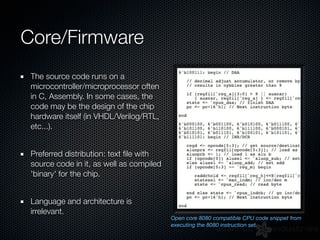
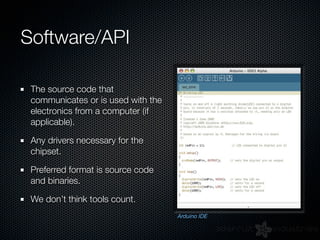
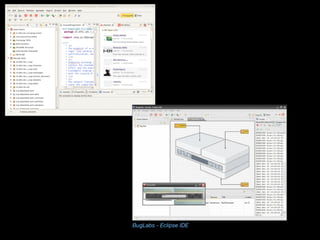
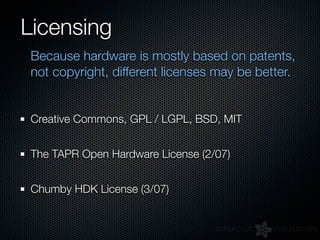
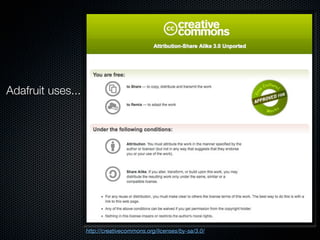
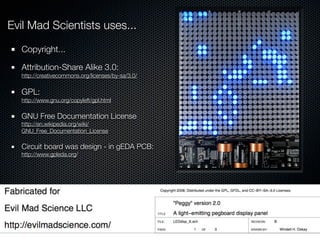
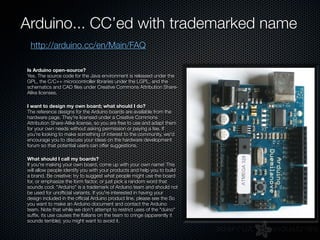
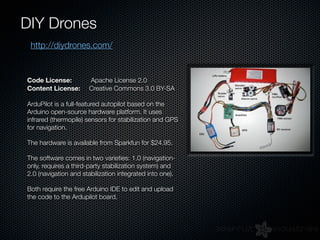
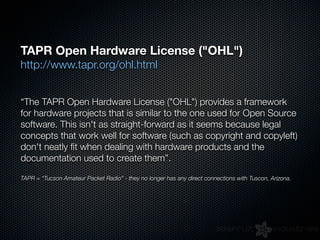
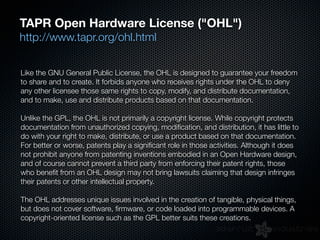

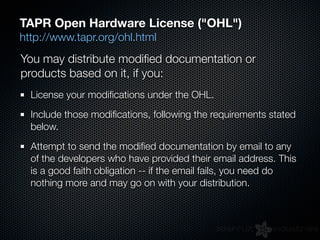
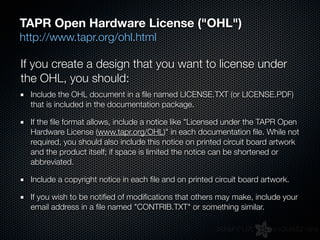

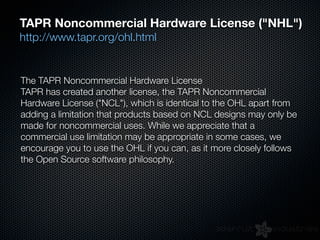
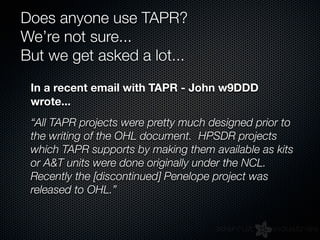
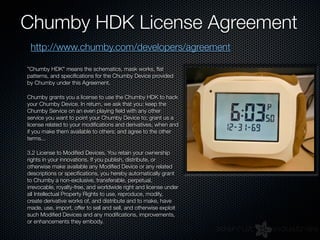
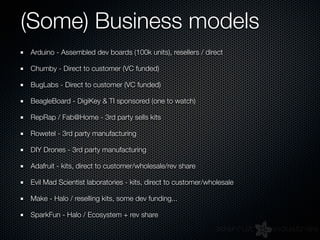
Ad
Recommended
Open source hardware
Open source hardwareEdmond Lau
╠²
This document discusses open source hardware. [1] Open source hardware consists of physical artifacts that are designed and shared in the same way as open source software, with information about the hardware design made easily available. [2] Examples of open source hardware include Arduino, an electronics prototyping platform, and BeagleBoard, a single-board computer. [3] Real-life projects using open source hardware include an Arduino-controlled RGB door lock and an Android Open Accessory Kit integrated with an exercise bike.Open Source Hardware Summit Speech 2011
Open Source Hardware Summit Speech 2011arduinoteam
╠²
The document discusses Arduino, an open-source electronics prototyping platform. It provides details on Arduino's business model, hardware, software, documentation licenses, sales numbers, university and company adoption, community forum stats, and lessons learned. Key points include Arduino being designed for beginners, its open hardware and software model, annual sales increasing to over 300,000 units, partnerships with over 200 distributors worldwide, and an active online forum community.Be Hacker
Be HackerHiro Yoshioka
╠²
Rakuten is hiring engineers and hackers. The document discusses Rakuten's mission to empower engineers and build a hacker-centric culture. It provides information on technical meetings and code reading parties organized by Rakuten and the Yokohama Linux Users Group to learn new technologies and meet experts.Programming the Real World: Javascript for Makers
Programming the Real World: Javascript for Makerspchristensen
╠²
The document discusses the appeal of programming and the unique aspects of software creation in comparison to traditional crafts, emphasizing the broader access and lower costs of producing and distributing software. It covers the growing maker movement, detailing tools and resources available for hardware experimentation and prototyping, as well as the integration of software with hardware through platforms like Arduino and Raspberry Pi. Ultimately, it encourages readers to explore hardware projects, get involved in communities, and unleash their creativity in making smarter objects in the physical world.Cross-collaborative innovation, hackerspaces, and patents
Cross-collaborative innovation, hackerspaces, and patentsTom Grek
╠²
The document discusses the evolution of maker culture and the importance of cross-collaboration in innovation, highlighting the roles of various stakeholders in the patent process. It explores the paradigm of open innovation, emphasizing the need for companies to leverage external ideas and resources while sharing risks and rewards. The history of patents in the context of 3D printing and collaboration among companies like LEGO and MIT is also examined, illustrating the shifts in public opinion and entrepreneurial culture over the decades.Using oss at an internet company and hacker culture
Using oss at an internet company and hacker cultureHiro Yoshioka
╠²
Hiro Yoshioka, the Technical Managing Officer at Rakuten, discusses the use of open source software (OSS) within the company and its connection to hacker culture. He emphasizes the importance of fostering a hacker-centric culture to enhance innovation, collaboration, and productivity among engineers. The presentation covers hacker ethics, community engagement in OSS development, and the benefits of OSS, including flexibility and quality improvements.UI Beyond the Browser - Software for Hardware Projects
UI Beyond the Browser - Software for Hardware Projectspchristensen
╠²
The document discusses the unique characteristics of software and hardware in the context of the maker movement, emphasizing how software's low marginal costs and easy distribution differ from traditional manufacturing. It explores various tools and resources available for designing and prototyping hardware, alongside opportunities for collaboration and community involvement. The text also highlights the potential for innovative projects that integrate software with tangible objects, inviting readers to explore possibilities beyond conventional programming.Open hardware - Primeros pasos con ArduinoAlberto Labarga
╠²
El documento discute la historia y evoluci├│n del software y hardware libre, destacando la importancia del Proyecto GNU y la creaci├│n de Linux, as├Ł como el impacto de empresas como Microsoft en este ├Īmbito. Adem├Īs, presenta conceptos fundamentales de electr├│nica y programaci├│n utilizando Arduino, incluyendo componentes el├®ctricos, circuitos y el entorno de desarrollo. Se enfatiza el valor del conocimiento abierto y la posibilidad de modificar y redistribuir software y hardware libremente.Open source hardware and the web
Open source hardware and the webada fruit
╠²
The document discusses open source hardware, its definitions, licensing, and challenges compared to software. It outlines various components necessary for hardware design, preferred documentation types, and licensing solutions tailored for hardware, such as creative commons and GPL. Additionally, it covers business models for open source hardware projects, various platforms, and tools available for development.D├®finition et mod├©le ├®conomique du l'open hardware'zakaria nakrachi'
D├®finition et mod├©le ├®conomique du l'open hardware'zakaria nakrachi'opentaqafa
╠²
Open-source hardware (OSH) refers to technology that is designed and shared similarly to free and open-source software (FOSS), emphasizing easily accessible design information. It is part of the open-source culture movement and can utilize existing software licenses such as LGPL, GPL, and proprietary licenses, while also addressing patent and copyright issues. Examples of OSH projects include Arduino, BeagleBone, and Reprap, showcasing the collaborative sharing of hardware designs.2011wpi
2011wpieshuy
╠²
The document discusses the iCub robot project, an open-source humanoid robot that costs Ōé¼200,000 to build. It provides an overview of the iCub specifications and licensing, comparing it to other open hardware projects like Arduino, RepRap, and the Global Village Construction Set. While the iCub design is publicly available under open-source licenses, it is noted that the licensing and documentation of hardware presents unique challenges compared to software.Free Robotics
Free Roboticseshuy
╠²
The document discusses the iCub robot project, an open-source humanoid robot that costs Ōé¼200,000 to build. It examines how the iCub stacks up to definitions of open-source hardware, compares it to other open hardware projects like Arduino and RepRap, and discusses challenges around patents and licensing hardware designs. The document argues that open-source approaches can help collaboration on complex robotic projects like humanoids.Open Source Hardware for Dummies
Open Source Hardware for DummiesRobert Viseur
╠²
This document summarizes an open hardware presentation about business models for open source hardware. It discusses several examples of commercial open hardware projects:
- LEON is an open source processor model used in Aeroflex Gaisler's products. They use a dual licensing model with GPL and commercial licenses.
- Arduino is an open source electronics prototyping platform manufactured by Smart Projects. It has been very successful due to its low cost, integrated tools, and large ecosystem. Revenues come from product sales and services.
- Elphel produces open source network cameras and collaborated with Google on camera projects. Future projects include the open source Apertus cinema camera.
The document also discusses open source definitionsBusiness models of open hardware
Business models of open hardwareRobert Viseur
╠²
This document discusses business models for open hardware. It begins with an overview of software licenses, including proprietary, hybrid, and free software licenses. Free software licenses can have reciprocity requirements. For open hardware, value is created through collaboration but captured indirectly through services typically. Examples of successful open hardware companies discussed include Arduino, which uses a dual licensing model, and Elphel, which releases hardware and software under GPLv2. New opportunities may arise from advances in CAD software and 3D printing.L'open hardware dans l'├®lectronique (et au del├Ā...)
L'open hardware dans l'├®lectronique (et au del├Ā...)Robert Viseur
╠²
The document presents an overview of open source hardware and software, detailing various software licenses including free software and proprietary options. It also discusses business models related to free and open source software, as well as definitions and protections applicable to open hardware. Additionally, it provides examples of successful open hardware projects and addresses the evolution of concepts related to openness in technology.Open Source Hardware at OTA11
Open Source Hardware at OTA11Paul Downey
╠²
This document provides an introduction to open source hardware and discusses its importance. It includes a list of hyperlinks to various open source hardware projects and communities. The key topics covered are open hardware, open source standards, examples of open source hardware projects in areas like computing and transportation, and the benefits of openness including innovation, collaboration, and sharing designs for non-commercial purposes.Open Source Hardware and Libre Silicon
Open Source Hardware and Libre SiliconDrew Fustini
╠²
The document discusses open source hardware (OSH) and libre silicon principles, emphasizing the importance of publicly available designs for studying, modifying, and distributing hardware. It highlights the definition and principles of open source and free software, provides examples like Arduino, and outlines various licenses for sharing hardware designs. The document also covers the community-driven initiatives and resources, such as the Open Source Hardware Association and the Open Hardware Summit, promoting collaboration and accessibility in technology development.Open Source Hardware
Open Source HardwareMarcin Pioch
╠²
The document discusses open source hardware. It begins with defining open source hardware and its key principles. It then provides a brief history of open source hardware, including early projects and the establishment of organizations. Statistics are presented on open source hardware startups, founders, markets, and funding. Business models, licenses, and examples of open source hardware projects in various fields like electronics, automotive, cameras, machines/tools, robotics, and others are outlined. The document aims to provide an overview of open source hardware. Free and Open Source Software Tools for Making Open Source Hardware
Free and Open Source Software Tools for Making Open Source HardwareLeon Anavi
╠²
The document presents an overview of free and open source software tools for designing open source hardware, covering essential topics such as open source licenses, software for PCB design, and 3D CAD applications. It highlights notable open source hardware projects and recommends various software tools, emphasizing their benefits for customization and community collaboration. The conclusion suggests that open source hardware can be a viable business model supported by high-quality open source software resources.Embedded Recipes 2019 - Linux on Open Source Hardware and Libre Silicon
Embedded Recipes 2019 - Linux on Open Source Hardware and Libre SiliconAnne Nicolas
╠²
The document discusses the principles and practices of open-source hardware and software, emphasizing the importance of public accessibility for design modifications and collaborations. It highlights successful examples like Arduino and BeagleBoard, detailing various licenses and community initiatives that support open-source standards. Additionally, it covers advancements in open-source silicon technology, such as RISC-V architecture and contributions from organizations like the FOSS Silicon Foundation.What Is Open Source Hardware?
What Is Open Source Hardware?inthebitz
╠²
The document explores the concept of "open source hardware," detailing its various interpretations regarding accessibility, cost, and replicability. It discusses the importance of factors such as availability of schematics, programming interfaces, and the capacity for individuals to modify and resell the hardware. The authors emphasize community engagement and learning, noting the strengths and challenges of open source hardware initiatives in fostering accessibility and innovation.Arduino and Open Hardware
Arduino and Open HardwareTinker
╠²
Arduino, developed by Daniel Soltis and others in 2005, is an open-source hardware platform widely distributed with over 60,000 units sold. It promotes a culture of shared code and peer support, with various boards and projects inspired by the Arduino name. The platform is supported by a community of users, including hobbyists, designers, and educational institutions.Arduino and Open Hardware
Arduino and Open HardwareTinker London
╠²
The Arduino is an open-source hardware platform for building prototypes and interactive objects. It was designed in academia in 2005 and is now distributed in 28 countries, having sold over 60,000 units. The Arduino platform and software are available under open licenses, and an active community shares code and schematics online to support users. Both commercial and non-commercial developers create add-ons, projects, and products using Arduino boards.If3514351438
If3514351438IJERA Editor
╠²
The document analyzes the current trends in the open source hardware community, highlighting its benefits such as accessibility, modification freedom, and collaboration. It contrasts open source with closed source development, noting the drawbacks of the latter, including cost and lack of user control. The paper emphasizes the importance of systematic and organized development for enhancing open source hardware, suggesting that increased adoption will lead to new research areas in hardware design.Intro to Open Source Hardware (OSHW)
Intro to Open Source Hardware (OSHW)Drew Fustini
╠²
The document discusses the principles and practices of open source hardware (OSHW), including the necessary documentation for design, relevant licenses, and examples such as Arduino and the CERN Open Hardware License. It highlights initiatives like the Open Source Hardware Association (OSHWA) and various open hardware projects in science and technology, as well as the open hardware certification program. Additionally, it touches on recent open hardware summits and encourages community participation in innovative and collaborative development.Linux on Open Source Hardware
Linux on Open Source HardwareDrew Fustini
╠²
The document discusses open source hardware (OSH) practices, emphasizing the importance of sharing design documentation and using open licenses like Creative Commons and CERN's Open Hardware License. It highlights various examples of OSH projects, including BeagleBoard and CHIP, and promotes collaboration in hardware development through platforms like the Open Hardware Repository. Additionally, it addresses the significance of the Open Source Hardware Association and its role in supporting the community and establishing best practices.Open Source Hardware (OSHW)...What About The Tools?
Open Source Hardware (OSHW)...What About The Tools?ChrisGammell
╠²
Open Source Hardware can be designed with both open and closed tools. While closed tools pose risks like vendor lock-in, many successful open hardware projects have been designed with non-open tools. Fully open tools that are gratis, libre, and use open standards provide the greatest benefits like longevity and ability for others to modify and build upon designs. As complexity increases, the availability of capable low-cost or free tools is declining. Improving open tools through sponsorship, standards, and contests can help speed innovation for open hardware.Linux on Open Source Hardware with Open Source chip design (36c3)
Linux on Open Source Hardware with Open Source chip design (36c3)Drew Fustini
╠²
The document discusses the principles and practices surrounding open source hardware and chip design, emphasizing the importance of publicly accessible designs for collaborative development. It highlights various successful examples, including projects like Arduino and BeagleBoard, and covers the role of licenses such as the CERN Open Hardware License. The text also touches on developments in the RISC-V architecture and other open source initiatives aimed at making hardware design accessible and affordable.A Constitutional Quagmire - Ethical Minefields of AI, Cyber, and Privacy.pdf
A Constitutional Quagmire - Ethical Minefields of AI, Cyber, and Privacy.pdfPriyanka Aash
╠²
A Constitutional Quagmire - Ethical Minefields of AI, Cyber, and PrivacyFIDO Seminar: New Data: Passkey Adoption in the Workforce.pptx
FIDO Seminar: New Data: Passkey Adoption in the Workforce.pptxFIDO Alliance
╠²
FIDO Seminar: New Data: Passkey Adoption in the WorkforceMore Related Content
Similar to open source hardware overview (20)
Open source hardware and the web
Open source hardware and the webada fruit
╠²
The document discusses open source hardware, its definitions, licensing, and challenges compared to software. It outlines various components necessary for hardware design, preferred documentation types, and licensing solutions tailored for hardware, such as creative commons and GPL. Additionally, it covers business models for open source hardware projects, various platforms, and tools available for development.D├®finition et mod├©le ├®conomique du l'open hardware'zakaria nakrachi'
D├®finition et mod├©le ├®conomique du l'open hardware'zakaria nakrachi'opentaqafa
╠²
Open-source hardware (OSH) refers to technology that is designed and shared similarly to free and open-source software (FOSS), emphasizing easily accessible design information. It is part of the open-source culture movement and can utilize existing software licenses such as LGPL, GPL, and proprietary licenses, while also addressing patent and copyright issues. Examples of OSH projects include Arduino, BeagleBone, and Reprap, showcasing the collaborative sharing of hardware designs.2011wpi
2011wpieshuy
╠²
The document discusses the iCub robot project, an open-source humanoid robot that costs Ōé¼200,000 to build. It provides an overview of the iCub specifications and licensing, comparing it to other open hardware projects like Arduino, RepRap, and the Global Village Construction Set. While the iCub design is publicly available under open-source licenses, it is noted that the licensing and documentation of hardware presents unique challenges compared to software.Free Robotics
Free Roboticseshuy
╠²
The document discusses the iCub robot project, an open-source humanoid robot that costs Ōé¼200,000 to build. It examines how the iCub stacks up to definitions of open-source hardware, compares it to other open hardware projects like Arduino and RepRap, and discusses challenges around patents and licensing hardware designs. The document argues that open-source approaches can help collaboration on complex robotic projects like humanoids.Open Source Hardware for Dummies
Open Source Hardware for DummiesRobert Viseur
╠²
This document summarizes an open hardware presentation about business models for open source hardware. It discusses several examples of commercial open hardware projects:
- LEON is an open source processor model used in Aeroflex Gaisler's products. They use a dual licensing model with GPL and commercial licenses.
- Arduino is an open source electronics prototyping platform manufactured by Smart Projects. It has been very successful due to its low cost, integrated tools, and large ecosystem. Revenues come from product sales and services.
- Elphel produces open source network cameras and collaborated with Google on camera projects. Future projects include the open source Apertus cinema camera.
The document also discusses open source definitionsBusiness models of open hardware
Business models of open hardwareRobert Viseur
╠²
This document discusses business models for open hardware. It begins with an overview of software licenses, including proprietary, hybrid, and free software licenses. Free software licenses can have reciprocity requirements. For open hardware, value is created through collaboration but captured indirectly through services typically. Examples of successful open hardware companies discussed include Arduino, which uses a dual licensing model, and Elphel, which releases hardware and software under GPLv2. New opportunities may arise from advances in CAD software and 3D printing.L'open hardware dans l'├®lectronique (et au del├Ā...)
L'open hardware dans l'├®lectronique (et au del├Ā...)Robert Viseur
╠²
The document presents an overview of open source hardware and software, detailing various software licenses including free software and proprietary options. It also discusses business models related to free and open source software, as well as definitions and protections applicable to open hardware. Additionally, it provides examples of successful open hardware projects and addresses the evolution of concepts related to openness in technology.Open Source Hardware at OTA11
Open Source Hardware at OTA11Paul Downey
╠²
This document provides an introduction to open source hardware and discusses its importance. It includes a list of hyperlinks to various open source hardware projects and communities. The key topics covered are open hardware, open source standards, examples of open source hardware projects in areas like computing and transportation, and the benefits of openness including innovation, collaboration, and sharing designs for non-commercial purposes.Open Source Hardware and Libre Silicon
Open Source Hardware and Libre SiliconDrew Fustini
╠²
The document discusses open source hardware (OSH) and libre silicon principles, emphasizing the importance of publicly available designs for studying, modifying, and distributing hardware. It highlights the definition and principles of open source and free software, provides examples like Arduino, and outlines various licenses for sharing hardware designs. The document also covers the community-driven initiatives and resources, such as the Open Source Hardware Association and the Open Hardware Summit, promoting collaboration and accessibility in technology development.Open Source Hardware
Open Source HardwareMarcin Pioch
╠²
The document discusses open source hardware. It begins with defining open source hardware and its key principles. It then provides a brief history of open source hardware, including early projects and the establishment of organizations. Statistics are presented on open source hardware startups, founders, markets, and funding. Business models, licenses, and examples of open source hardware projects in various fields like electronics, automotive, cameras, machines/tools, robotics, and others are outlined. The document aims to provide an overview of open source hardware. Free and Open Source Software Tools for Making Open Source Hardware
Free and Open Source Software Tools for Making Open Source HardwareLeon Anavi
╠²
The document presents an overview of free and open source software tools for designing open source hardware, covering essential topics such as open source licenses, software for PCB design, and 3D CAD applications. It highlights notable open source hardware projects and recommends various software tools, emphasizing their benefits for customization and community collaboration. The conclusion suggests that open source hardware can be a viable business model supported by high-quality open source software resources.Embedded Recipes 2019 - Linux on Open Source Hardware and Libre Silicon
Embedded Recipes 2019 - Linux on Open Source Hardware and Libre SiliconAnne Nicolas
╠²
The document discusses the principles and practices of open-source hardware and software, emphasizing the importance of public accessibility for design modifications and collaborations. It highlights successful examples like Arduino and BeagleBoard, detailing various licenses and community initiatives that support open-source standards. Additionally, it covers advancements in open-source silicon technology, such as RISC-V architecture and contributions from organizations like the FOSS Silicon Foundation.What Is Open Source Hardware?
What Is Open Source Hardware?inthebitz
╠²
The document explores the concept of "open source hardware," detailing its various interpretations regarding accessibility, cost, and replicability. It discusses the importance of factors such as availability of schematics, programming interfaces, and the capacity for individuals to modify and resell the hardware. The authors emphasize community engagement and learning, noting the strengths and challenges of open source hardware initiatives in fostering accessibility and innovation.Arduino and Open Hardware
Arduino and Open HardwareTinker
╠²
Arduino, developed by Daniel Soltis and others in 2005, is an open-source hardware platform widely distributed with over 60,000 units sold. It promotes a culture of shared code and peer support, with various boards and projects inspired by the Arduino name. The platform is supported by a community of users, including hobbyists, designers, and educational institutions.Arduino and Open Hardware
Arduino and Open HardwareTinker London
╠²
The Arduino is an open-source hardware platform for building prototypes and interactive objects. It was designed in academia in 2005 and is now distributed in 28 countries, having sold over 60,000 units. The Arduino platform and software are available under open licenses, and an active community shares code and schematics online to support users. Both commercial and non-commercial developers create add-ons, projects, and products using Arduino boards.If3514351438
If3514351438IJERA Editor
╠²
The document analyzes the current trends in the open source hardware community, highlighting its benefits such as accessibility, modification freedom, and collaboration. It contrasts open source with closed source development, noting the drawbacks of the latter, including cost and lack of user control. The paper emphasizes the importance of systematic and organized development for enhancing open source hardware, suggesting that increased adoption will lead to new research areas in hardware design.Intro to Open Source Hardware (OSHW)
Intro to Open Source Hardware (OSHW)Drew Fustini
╠²
The document discusses the principles and practices of open source hardware (OSHW), including the necessary documentation for design, relevant licenses, and examples such as Arduino and the CERN Open Hardware License. It highlights initiatives like the Open Source Hardware Association (OSHWA) and various open hardware projects in science and technology, as well as the open hardware certification program. Additionally, it touches on recent open hardware summits and encourages community participation in innovative and collaborative development.Linux on Open Source Hardware
Linux on Open Source HardwareDrew Fustini
╠²
The document discusses open source hardware (OSH) practices, emphasizing the importance of sharing design documentation and using open licenses like Creative Commons and CERN's Open Hardware License. It highlights various examples of OSH projects, including BeagleBoard and CHIP, and promotes collaboration in hardware development through platforms like the Open Hardware Repository. Additionally, it addresses the significance of the Open Source Hardware Association and its role in supporting the community and establishing best practices.Open Source Hardware (OSHW)...What About The Tools?
Open Source Hardware (OSHW)...What About The Tools?ChrisGammell
╠²
Open Source Hardware can be designed with both open and closed tools. While closed tools pose risks like vendor lock-in, many successful open hardware projects have been designed with non-open tools. Fully open tools that are gratis, libre, and use open standards provide the greatest benefits like longevity and ability for others to modify and build upon designs. As complexity increases, the availability of capable low-cost or free tools is declining. Improving open tools through sponsorship, standards, and contests can help speed innovation for open hardware.Linux on Open Source Hardware with Open Source chip design (36c3)
Linux on Open Source Hardware with Open Source chip design (36c3)Drew Fustini
╠²
The document discusses the principles and practices surrounding open source hardware and chip design, emphasizing the importance of publicly accessible designs for collaborative development. It highlights various successful examples, including projects like Arduino and BeagleBoard, and covers the role of licenses such as the CERN Open Hardware License. The text also touches on developments in the RISC-V architecture and other open source initiatives aimed at making hardware design accessible and affordable.Recently uploaded (20)
A Constitutional Quagmire - Ethical Minefields of AI, Cyber, and Privacy.pdf
A Constitutional Quagmire - Ethical Minefields of AI, Cyber, and Privacy.pdfPriyanka Aash
╠²
A Constitutional Quagmire - Ethical Minefields of AI, Cyber, and PrivacyFIDO Seminar: New Data: Passkey Adoption in the Workforce.pptx
FIDO Seminar: New Data: Passkey Adoption in the Workforce.pptxFIDO Alliance
╠²
FIDO Seminar: New Data: Passkey Adoption in the Workforce9-1-1 Addressing: End-to-End Automation Using FME
9-1-1 Addressing: End-to-End Automation Using FMESafe Software
╠²
This session will cover a common use case for local and state/provincial governments who create and/or maintain their 9-1-1 addressing data, particularly address points and road centerlines. In this session, you'll learn how FME has helped Shelby County 9-1-1 (TN) automate the 9-1-1 addressing process; including automatically assigning attributes from disparate sources, on-the-fly QAQC of said data, and reporting. The FME logic that this presentation will cover includes: Table joins using attributes and geometry, Looping in custom transformers, Working with lists and Change detection.Improving Data Integrity: Synchronization between EAM and ArcGIS Utility Netw...
Improving Data Integrity: Synchronization between EAM and ArcGIS Utility Netw...Safe Software
╠²
Utilities and water companies play a key role in the creation of clean drinking water. The creation and maintenance of clean drinking water is becoming a critical problem due to pollution and pressure on the environment. A lot of data is necessary to create clean drinking water. For fieldworkers, two types of data are key: Asset data in an asset management system (EAM for example) and Geographic data in a GIS (ArcGIS Utility Network ). Keeping this type of data up to date and in sync is a challenge for many organizations, leading to duplicating data and creating a bulk of extra attributes and data to keep everything in sync. Using FME, it is possible to synchronize Enterprise Asset Management (EAM) data with the ArcGIS Utility Network in real time. Changes (creation, modification, deletion) in ArcGIS Pro are relayed to EAM via FME, and vice versa. This ensures continuous synchronization of both systems without daily bulk updates, minimizes risks, and seamlessly integrates with ArcGIS Utility Network services. This presentation focuses on the use of FME at a Dutch water company, to create a sync between the asset management and GIS.ŌĆ£Key Requirements to Successfully Implement Generative AI in Edge DevicesŌĆöOpt...
ŌĆ£Key Requirements to Successfully Implement Generative AI in Edge DevicesŌĆöOpt...Edge AI and Vision Alliance
╠²
For the full video of this presentation, please visit: https://www.edge-ai-vision.com/2025/06/key-requirements-to-successfully-implement-generative-ai-in-edge-devices-optimized-mapping-to-the-enhanced-npx6-neural-processing-unit-ip-a-presentation-from-synopsys/
Gordon Cooper, Principal Product Manager at Synopsys, presents the ŌĆ£Key Requirements to Successfully Implement Generative AI in Edge DevicesŌĆöOptimized Mapping to the Enhanced NPX6 Neural Processing Unit IPŌĆØ tutorial at the May 2025 Embedded Vision Summit.
In this talk, Cooper discusses emerging trends in generative AI for edge devices and the key role of transformer-based neural networks. He reviews the distinct attributes of transformers, their advantages over conventional convolutional neural networks and how they enable generative AI.
Cooper then covers key requirements that must be met for neural processing units (NPU) to support transformers and generative AI in edge device applications. He uses transformer-based generative AI examples to illustrate the efficient mapping of these workloads onto the enhanced Synopsys ARC NPX NPU IP family.Coordinated Disclosure for ML - What's Different and What's the Same.pdf
Coordinated Disclosure for ML - What's Different and What's the Same.pdfPriyanka Aash
╠²
Coordinated Disclosure for ML - What's Different and What's the SameThe Future of Technology: 2025-2125 by Saikat Basu.pdf
The Future of Technology: 2025-2125 by Saikat Basu.pdfSaikat Basu
╠²
A peek into the next 100 years of technology. From Generative AI to Global AI networks to Martian Colonisation to Interstellar exploration to Industrial Nanotechnology to Artificial Consciousness, this is a journey you don't want to miss. Which ones excite you the most? Which ones are you apprehensive about? Feel free to comment! Let the conversation begin!OpenPOWER Foundation & Open-Source Core Innovations
OpenPOWER Foundation & Open-Source Core InnovationsIBM
╠²
penPOWER offers a fully open, royalty-free CPU architecture for custom chip design.
It enables both lightweight FPGA cores (like Microwatt) and high-performance processors (like POWER10).
Developers have full access to source code, specs, and tools for end-to-end chip creation.
It supports AI, HPC, cloud, and embedded workloads with proven performance.
Backed by a global community, it fosters innovation, education, and collaboration."How to survive Black Friday: preparing e-commerce for a peak season", Yurii ...
"How to survive Black Friday: preparing e-commerce for a peak season", Yurii ...Fwdays
╠²
We will explore how e-commerce projects prepare for the busiest time of the year, which key aspects to focus on, and what to expect. WeŌĆÖll share our experience in setting up auto-scaling, load balancing, and discuss the loads that Silpo handles, as well as the solutions that help us navigate this season without failures.OWASP Barcelona 2025 Threat Model Library
OWASP Barcelona 2025 Threat Model LibraryPetraVukmirovic
╠²
Threat Model Library Launch at OWASP Barcelona 2025
https://owasp.org/www-project-threat-model-library/CapCut Pro Crack For PC Latest Version {Fully Unlocked} 2025
CapCut Pro Crack For PC Latest Version {Fully Unlocked} 2025pcprocore
╠²
¤æēØŚĪØŚ╝ØśüØŚ▓:ØŚ¢ØŚ╝ØŚĮØśå ØŚ╣ØŚČØŚ╗ØŚĖ & ØŚĮØŚ«ØśĆØśüØŚ▓ ØŚČØŚ╗ØśüØŚ╝ ØŚÜØŚ╝ØŚ╝ØŚ┤ØŚ╣ØŚ▓ ØŚ╗ØŚ▓Øśä ØśüØŚ«ØŚ»> https://pcprocore.com/ ¤æłŌŚĆ
CapCut Pro Crack is a powerful tool that has taken the digital world by storm, offering users a fully unlocked experience that unleashes their creativity. With its user-friendly interface and advanced features, itŌĆÖs no wonder why aspiring videographers are turning to this software for their projects.Creating Inclusive Digital Learning with AI: A Smarter, Fairer Future
Creating Inclusive Digital Learning with AI: A Smarter, Fairer FutureImpelsys Inc.
╠²
Have you ever struggled to read a tiny label on a medicine box or tried to navigate a confusing website? Now imagine if every learning experience felt that wayŌĆöevery single day.
For millions of people living with disabilities, poorly designed content isnŌĆÖt just frustrating. ItŌĆÖs a barrier to growth. Inclusive learning is about fixing that. And today, AI is helping us build digital learning thatŌĆÖs smarter, kinder, and accessible to everyone.
Accessible learning increases engagement, retention, performance, and inclusivity for everyone. Inclusive design is simply better design.FIDO Seminar: Perspectives on Passkeys & Consumer Adoption.pptx
FIDO Seminar: Perspectives on Passkeys & Consumer Adoption.pptxFIDO Alliance
╠²
FIDO Seminar: Perspectives on Passkeys & Consumer Adoption"Database isolation: how we deal with hundreds of direct connections to the d...
"Database isolation: how we deal with hundreds of direct connections to the d...Fwdays
╠²
What can go wrong if you allow each service to access the database directly? In a startup, this seems like a quick and easy solution, but as the system scales, problems appear that no one could have guessed.
In my talk, I'll share Solidgate's experience in transforming its architecture: from the chaos of direct connections to a service-based data access model. I will talk about the transition stages, bottlenecks, and how isolation affected infrastructure support. I will honestly show what worked and what didn't. In short, we will analyze the controversy of this talk.The Future of AI Agent Development Trends to Watch.pptx
The Future of AI Agent Development Trends to Watch.pptxLisa ward
╠²
The Future of AI Agent Development: Trends to Watch explores emerging innovations shaping smarter, more autonomous AI solutions for businesses and technology.
2025_06_18 - OpenMetadata Community Meeting.pdf
2025_06_18 - OpenMetadata Community Meeting.pdfOpenMetadata
╠²
The community meetup was held Wednesday June 18, 2025 @ 9:00 AM PST.
Catch the next OpenMetadata Community Meetup @ https://www.meetup.com/openmetadata-meetup-group/
In this month's OpenMetadata Community Meetup, "Enforcing Quality & SLAs with OpenMetadata Data Contracts," we covered data contracts, why they matter, and how to implement them in OpenMetadata to increase the quality of your data assets!
Agenda Highlights:
¤æŗ Introducing Data Contracts: An agreement between data producers and consumers
¤ōØ Data Contracts key components: Understanding a contract and its purpose
¤¦æŌĆŹ¤Ä© Writing your first contract: How to create your own contracts in OpenMetadata
¤”Š An OpenMetadata MCP Server update!
Ō×Ģ And More!Oh, the Possibilities - Balancing Innovation and Risk with Generative AI.pdf
Oh, the Possibilities - Balancing Innovation and Risk with Generative AI.pdfPriyanka Aash
╠²
Oh, the Possibilities - Balancing Innovation and Risk with Generative AITechniques for Automatic Device Identification and Network Assignment.pdf
Techniques for Automatic Device Identification and Network Assignment.pdfPriyanka Aash
╠²
Techniques for Automatic Device Identification and Network AssignmentŌĆ£Key Requirements to Successfully Implement Generative AI in Edge DevicesŌĆöOpt...
ŌĆ£Key Requirements to Successfully Implement Generative AI in Edge DevicesŌĆöOpt...Edge AI and Vision Alliance
╠²
Ad
